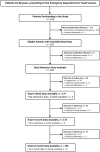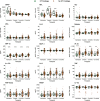Chronic immunosuppression across 12 months and high ability of acute and subacute CNS-injury biomarker concentrations to identify individuals with complicated mTBI on acute CT and MRI
- PMID: 38678300
- PMCID: PMC11056044
- DOI: 10.1186/s12974-024-03094-8
Chronic immunosuppression across 12 months and high ability of acute and subacute CNS-injury biomarker concentrations to identify individuals with complicated mTBI on acute CT and MRI
Abstract
Background: Identifying individuals with intracranial injuries following mild traumatic brain injury (mTBI), i.e. complicated mTBI cases, is important for follow-up and prognostication. The main aims of our study were (1) to assess the temporal evolution of blood biomarkers of CNS injury and inflammation in individuals with complicated mTBI determined on computer tomography (CT) and magnetic resonance imaging (MRI); (2) to assess the corresponding discriminability of both single- and multi-biomarker panels, from acute to chronic phases after injury.
Methods: Patients with mTBI (n = 207), defined as Glasgow Coma Scale score between 13 and 15, loss of consciousness < 30 min and post-traumatic amnesia < 24 h, were included. Complicated mTBI - i.e., presence of any traumatic intracranial injury on neuroimaging - was present in 8% (n = 16) on CT (CT+) and 12% (n = 25) on MRI (MRI+). Blood biomarkers were sampled at four timepoints following injury: admission (within 72 h), 2 weeks (± 3 days), 3 months (± 2 weeks) and 12 months (± 1 month). CNS biomarkers included were glial fibrillary acidic protein (GFAP), neurofilament light (NFL) and tau, along with 12 inflammation markers.
Results: The most discriminative single biomarkers of traumatic intracranial injury were GFAP at admission (CT+: AUC = 0.78; MRI+: AUC = 0.82), and NFL at 2 weeks (CT+: AUC = 0.81; MRI+: AUC = 0.89) and 3 months (MRI+: AUC = 0.86). MIP-1β and IP-10 concentrations were significantly lower across follow-up period in individuals who were CT+ and MRI+. Eotaxin and IL-9 were significantly lower in individuals who were MRI+ only. FGF-basic concentrations increased over time in MRI- individuals and were significantly higher than MRI+ individuals at 3 and 12 months. Multi-biomarker panels improved discriminability over single biomarkers at all timepoints (AUCs > 0.85 for admission and 2-week models classifying CT+ and AUC ≈ 0.90 for admission, 2-week and 3-month models classifying MRI+).
Conclusions: The CNS biomarkers GFAP and NFL were useful single diagnostic biomarkers of complicated mTBI, especially in acute and subacute phases after mTBI. Several inflammation markers were suppressed in patients with complicated versus uncomplicated mTBI and remained so even after 12 months. Multi-biomarker panels improved diagnostic accuracy at all timepoints, though at acute and 2-week timepoints, the single biomarkers GFAP and NFL, respectively, displayed similar accuracy compared to multi-biomarker panels.
Keywords: Concussion; Cytokines; Growth factors; Mixed-mechanism mild TBI; Neuroimaging; Prediction; Predictive modeling.
© 2024. The Author(s).
Conflict of interest statement
The authors declare no competing interests.
Figures




Similar articles
-
Longitudinal Associations Between Persistent Post-Concussion Symptoms and Blood Biomarkers of Inflammation and CNS-Injury After Mild Traumatic Brain Injury.J Neurotrauma. 2024 Apr;41(7-8):862-878. doi: 10.1089/neu.2023.0419. Epub 2024 Jan 24. J Neurotrauma. 2024. PMID: 38117157
-
Glial fibrillary acidic protein elevations relate to neuroimaging abnormalities after mild TBI.Neurology. 2018 Oct 9;91(15):e1385-e1389. doi: 10.1212/WNL.0000000000006321. Epub 2018 Sep 12. Neurology. 2018. PMID: 30209234 Free PMC article.
-
Utility of Acute and Subacute Blood Biomarkers to Assist Diagnosis in CT-Negative Isolated Mild Traumatic Brain Injury.Neurology. 2023 Nov 14;101(20):e1992-e2004. doi: 10.1212/WNL.0000000000207881. Epub 2023 Oct 3. Neurology. 2023. PMID: 37788938 Free PMC article.
-
Neuropathology of Mild Traumatic Brain Injury: Correlation to Neurocognitive and Neurobehavioral Findings.In: Kobeissy FH, editor. Brain Neurotrauma: Molecular, Neuropsychological, and Rehabilitation Aspects. Boca Raton (FL): CRC Press/Taylor & Francis; 2015. Chapter 31. In: Kobeissy FH, editor. Brain Neurotrauma: Molecular, Neuropsychological, and Rehabilitation Aspects. Boca Raton (FL): CRC Press/Taylor & Francis; 2015. Chapter 31. PMID: 26269912 Free Books & Documents. Review.
-
Exploring Serum Biomarkers for Mild Traumatic Brain Injury.In: Kobeissy FH, editor. Brain Neurotrauma: Molecular, Neuropsychological, and Rehabilitation Aspects. Boca Raton (FL): CRC Press/Taylor & Francis; 2015. Chapter 22. In: Kobeissy FH, editor. Brain Neurotrauma: Molecular, Neuropsychological, and Rehabilitation Aspects. Boca Raton (FL): CRC Press/Taylor & Francis; 2015. Chapter 22. PMID: 26269900 Free Books & Documents. Review.
Cited by
-
Extracranial Effects of Traumatic Brain Injury: A Narrative Review.Clin Pract. 2025 Feb 25;15(3):47. doi: 10.3390/clinpract15030047. Clin Pract. 2025. PMID: 40136583 Free PMC article. Review.
-
Neuroinflammation: Mechanisms, Dual Roles, and Therapeutic Strategies in Neurological Disorders.Curr Issues Mol Biol. 2025 Jun 4;47(6):417. doi: 10.3390/cimb47060417. Curr Issues Mol Biol. 2025. PMID: 40699816 Free PMC article. Review.
-
Association of Traumatic Meningeal Enhancement on MRI With Clinical Recovery in Patients With Traumatic Brain Injury.Neurology. 2025 Mar 25;104(6):e213448. doi: 10.1212/WNL.0000000000213448. Epub 2025 Feb 25. Neurology. 2025. PMID: 39999394
References
-
- Cassidy JD, Carroll LJ, Peloso PM, et al. Incidence, risk factors and prevention of mild traumatic brain injury: results of the WHO Collaborating Centre Task Force on mild traumatic brain Injury. J Rehabil Med. 2004;43 Suppl28–60. 10.1080/16501960410023732. - PubMed
-
- Hütter B-O, Altmeppen J, Kraff O, et al. Higher sensitivity for traumatic cerebral microbleeds at 7 T ultra-high field MRI: is it clinically significant for the acute state of the patients and later quality of life? Ther Adv Neurol Disord. 2020;13:1756286420911295. doi: 10.1177/1756286420911295. - DOI - PMC - PubMed
MeSH terms
Substances
LinkOut - more resources
Full Text Sources
Medical
Miscellaneous

